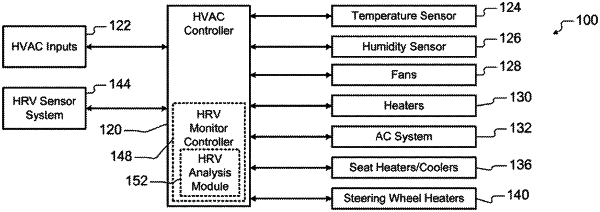| CPC A61B 5/6893 (2013.01) [A61B 5/0006 (2013.01); A61B 5/0008 (2013.01); A61B 5/0022 (2013.01); A61B 5/02405 (2013.01); A61B 5/7264 (2013.01); B60H 1/00742 (2013.01); F24F 11/58 (2018.01); F24F 11/64 (2018.01); F24F 11/65 (2018.01); F24F 2110/10 (2018.01); F24F 2110/20 (2018.01); F24F 2110/30 (2018.01); F24F 2120/14 (2018.01); F24F 2130/20 (2018.01)] | 22 Claims |

|
1. A temperature control system, comprising:
a heating, ventilation and air conditioning (HVAC) system configured to control temperature in an environment;
a sensor configured to generate an electrocardiogram (ECG) signal for an occupant of the environment;
an environmental sensor configured to sense environmental data selected from a group consisting of the environmental temperature, an ambient temperature, air velocity, sun load and humidity; and
a heart rate variability (HRV) controller configured to:
receive the ECG signal;
identify inter-beat intervals based on the ECG signal; and
control the HVAC system based on the inter-beat intervals and the environmental data, wherein the HRV controller is further configured to:
compare the inter-beat intervals to a first threshold and a second threshold, wherein the first threshold is less than the second threshold;
increase heating in the environment when at least one of the inter-beat intervals is less than the first threshold; and
increase cooling in the environment when at least one of the inter-beat intervals is greater than the second threshold.
|